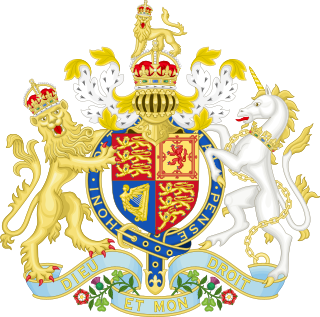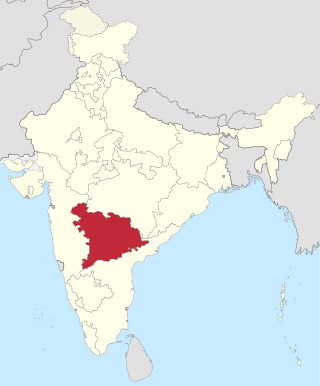Related Research Articles

The Hyderabad State or Hyderabad Deccan was a kingdom, and then princely state of India in the south-central Deccan region with its capital at the city of Hyderabad. It is now divided between the present-day state of Telangana, the Kalyana-Karnataka region of Karnataka, and the Marathwada region of Maharashtra in India.

The princely state of Hyderabad was annexed by India in September 1948 through a military operation code-named Operation Polo, which was dubbed a "police action".

Nizam of Hyderabad was the title of the ruler of Hyderabad State. Nizam is a shortened form of Niẓām ul-Mulk, and was the title bestowed upon Asaf Jah I when he was appointed Viceroy of the Deccan by the Mughal Emperor Farrukhsiyar. In addition to being the Mughal Viceroy (Naib) of the Deccan, Asaf Jah I was also the premier courtier of the Mughal Empire until 1724, when he established an independent realm based in Hyderabad, but in practice, continued to recognise the nominal authority of emperor.

The Indian Independence Act 1947 is an act of the Parliament of the United Kingdom that partitioned British India into the two new independent dominions of India and Pakistan. The Act received Royal Assent on 18 July 1947 and thus modern-day India and Pakistan, comprising west and east regions, came into being on 15 August.

Hyderabadi Muslims, also referred to as Hyderabadis, are a community of Deccani people, from the area that used to be the princely state of Hyderabad in the regions of Marathwada, Telangana, and Kalyana-Karnataka.

Before India gained independence in 1947, India was divided into two sets of territories, one under direct British rule, and the other consisting of princely states under the suzerainty of the British Crown, with control over their internal affairs remaining in the hands of their hereditary rulers. The latter included 562 princely states which had different types of revenue-sharing arrangements with the British, often depending on their size, population and local conditions. In addition, there were several colonial enclaves controlled by France and Portugal. After independence, the political integration of these territories into an Indian Union was a declared objective of the Indian National Congress, and the Government of India pursued this over the next decade.

Kasim Razvi was a politician in the princely state of Hyderabad. He was the president of the Majlis-e-Ittehadul Muslimeen party from December 1946 until the state's Annexation in 1948. He was also the founder of the Razakar militia in the state. He held the levers of power with the Nizam of Hyderabad, blocking the possibilities of his accommodation with the Dominion of India.

The Razakars were a paramilitary force and homeguard in Hyderabad State whose goals were to defend Hyderabad in the face of an Indian invasion. Formed in 1938 by the MIM leader Bahadur Yar Jung, the organisation expanded considerably during the leadership of Qasim Razvi by the time of India's annexation of the country. Although primarily associated with the Muslim political party Majlis-e-Ittehadul Muslimeen (MIM), it quickly began to draw Dalits and other Hyderabadi Hindus into its ranks, in addition to later collaborating with the communists in 1948. The organization has become a renewed topic of discussion in modern-day India due to a historical film released in 2024.

Ballari, formerly Bellary, is a major district in Karnataka. It is located at north-eastern part of Karnataka. This district belongs to Kalyana-Karnataka. This district was one of the biggest districts in Karnataka until the Vijayanagara district was carved out of Ballari district in 2021 officially.

The Unification of Karnataka or Karnataka Ekikarana refers to the formation of the Indian state of Karnataka in 1956 when several Indian states were created by redrawing borders based on linguistic demographics. Decades earlier during British rule, the demand for a state based on Kannada demographics had been made.
Mallu Venkata Narasimha Reddy was an Indian revolutionary leader and one of the prominent heroes of the Telangana Rebellion. Remained underground for nine long years, he had organised the armed squads in battling the Nizam's army and the razakars. He steadfastly upheld the revolutionary tenets of Marxism–Leninism and played an important role when both the revisionist and the Left adventurist divisions had deeply divided the communist movement in Andhra Pradesh.
Rao Bahadur Pemmanda K. Monnappa was a police officer of South India. He served in three Southern states, Madras, Hyderabad and Mysore (Karnataka), at different times. However, he is to be best remembered for his contributions towards the integration of Hyderabad into the Union. Monnappa had a career in the Public Service reflected by his titles and medals.

Lieutenant Colonel Saeed ul-Mulk Nawab Sir Muhammad Ahmad Said Khan, Nawab of Chhatari also generally referred to as Nawab of Chhatari was Governor of the United Provinces, Chief Minister of United Provinces, President of the Executive Council of the Nizam of Hyderabad and Chief Scout of India.
The Hyderabad State Congress was a political party in the princely state of Hyderabad that sought civil rights, representative democracy and the union of Hyderabad with the Republic of India. It opposed the autocratic rule of the Nizam of Hyderabad and the militancy of the Razakars. HSC was formed in 1938.

Hyderabad State was a state in Dominion and later Republic of India, formed after the accession of the State of Hyderabad into the Union on 17 September 1948. It existed from 1948 to 1956. Hyderabad State comprised present day Telangana, Marathwada and Hyderabad-Karnataka

Kalyana-Karnataka, formerly known as Hyderabad-Karnataka, is a region located in the northern part of the Indian state of Karnataka, which was part of Kingdom of Hyderabad ruled by the Nizams and the Madras presidency of British India. The region comprises Bidar, Yadgir, Raichur, Koppal and Kalaburagi of Hyderabad state and, Ballari and Vijayanagara of the Madras province that are now present in the state of Karnataka. The Northeast-Karnataka region is the second largest arid region in India. Kalaburagi and Ballari are the largest cities of this region.

The history of Telangana, located on the high Deccan Plateau, includes its being ruled by the Satavahana Dynasty, the Kakatiya Dynasty (1083–1323), the Musunuri Nayaks (1326–1356), the Delhi Sultanate, the Bahmani Sultanate (1347–1512), Golconda Sultanate (1512–1687) and Asaf Jahi dynasty (1724–1950).

Marathwada Liberation Day, also known as Marathwada Mukti Sangram Din, is celebrated in Maharashtra on 17 September annually. It marks the anniversary of Marathwada's integration with India when the Indian military, liberated State of Hyderabad, and defeated the Nizam on 17 September 1948, 13 months after Indian independence.
A standstill agreement was an agreement signed between the newly independent dominions of India and Pakistan and the princely states of the British Indian Empire prior to their integration in the new dominions. The form of the agreement was bilateral between a dominion and a princely state. It provided that all the administrative arrangements, existing between the British Crown and the state would continue unaltered between the signatory dominion and the princely state, until new arrangements were made.

The Hyderabad massacres refers to the mass killings and massacre of Hyderabadi Muslims that took place simultaneously with the Indian annexation of Hyderabad. The killings were perpetrated by local Hindu fanatic militias, and by the Indian Army. The death toll of Muslims massacred in the process has been estimated to be at least 200,000. Apart from mass killings, activists such as Sundarayya mention systematic torture, rapes and lootings by Indian soldiers.
References
- ↑ "Hyderabad-Karnataka region celebrates Vimochana Diwas". DNA India. 18 September 2013. Retrieved 13 July 2022.
- ↑ Dr. Somanatha.C.H (May 2020). "The Freedom Struggle of Kalyana Karnataka. with Special Reference to Koppal and Ballari district" (PDF). International Journal of Research and Analytical Reviews. 7 (2): 455. ISSN 2348-1269 . Retrieved 13 July 2022.
- ↑ Mehrotra, S.R. (1979). Towards Indias Freedom And Partition. Delhi: Vikash Publishing House. p. 247 . Retrieved 17 August 2019.
- ↑ See Section 7 (1) (b): "the suzerainty of His Majesty over the Indian States lapses, and with it, all treaties and agreements in force at the date of the passing of this Act between His Majesty and the rulers of Indian States, all functions exercisable by His Majesty at that date with respect to Indian States, all obligations of His Majesty existing at that date towards Indian States or the rulers thereof, and all powers, rights, authority or jurisdiction exercisable by His Majesty at that date in or in relation to Indian States by treaty, grant, usage, sufferance or otherwise."
- 1 2 Barbara D. Metcalf; Thomas R. Metcalf (2006). A Concise History of India (2nd ed.). Cambridge University Press. ISBN 978-0521682251.
- ↑ "Delhi felt Razakars, communists a threat to India". Deccan Chronicle. 2018-09-15. Retrieved 2021-02-04.
- ↑ Ernst, Waltraud; Pati, Biswamoy (2007-10-18). India's Princely States: People, Princes and Colonialism. Routledge. ISBN 978-1-134-11988-2.
- ↑ "How Hyderabad came into the Indian union | India News - Times of India". The Times of India .
- ↑ "New book on Hyderabad's Invasion, 1948's Police Action". The Milli Gazette — Indian Muslims Leading News Source. Retrieved 2021-02-04.
- ↑ Sherman, Taylor C. (2007). "The integration of the princely state of Hyderabad and the making of the postcolonial state in India, 1948 – 56" (PDF). Indian Economic & Social History Review. 44 (4): 489–516. doi:10.1177/001946460704400404. S2CID 145000228.
- ↑ Chandra, Mukherjee & Mukherjee 2008, p. 96.
- ↑ Thomson, Mike (24 September 2013). "Hyderabad 1948: India's hidden massacre". BBC. Retrieved 24 September 2013.
- ↑ Noorani 2014 , Appendix 15: Confidential notes attached to the Sunderlal Committee Report, pp. 372–373
- ↑ "After Owaisi' plea, KCR govt says Sept 17 to be observed as 'Telangana National Integration Day'". 3 September 2022.